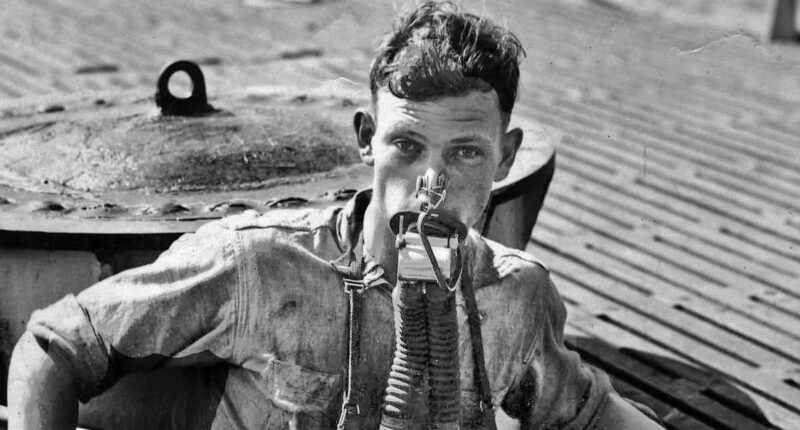Share this @internewscast.com
Everything seemed to move in slow motion, except for the torpedo slicing through the water at an alarming 30 knots.
Just five minutes earlier, the USS Tang had been riding high on a wave of success, poised to cement its legacy as the most triumphant American submarine in the Pacific theater.
However, their final torpedo veered off unexpectedly, making a sharp left turn and heading straight back towards the Tang.
On that October morning in 1944, of the 87 crew members aboard, up to 50 perished instantly when the torpedo struck.
Among the survivors, the majority suffered injuries.
Clayton Decker, who was stationed in the control room, emerged as one of the rare few to escape harm.
He helped Chief Bill Ballinger to his feet. Blood was leaking from a cut on Ballinger’s forehead, but he had enough foresight to know the pair’s only chance of survival was to get to the forward torpedo room, where the escape chamber was.
When they arrived, as many as 30 other men were already packed in there – the more severely injured lying in bunks, fully aware they would never escape.

The USS Tang was the most successful American submarine in the Pacific Ocean

The Tang’s crew, including Captain Richard H. O’Kane (center), photographed in May 1944 – four months before the catastrophic hit

One of the few unharmed crew members was Clayton Decker, who had been stationed in the control room
Ballinger estimated there were no more than four or five hours of air left. They needed an escape plan before the men began to slip into unconsciousness. It would not be easy.
‘Whenever you get a group of men together, you always have a couple of know-it-alls,’ said Decker. ‘We had a couple of them – one in particular.
‘This loudmouth and a chief torpedoman had crawled into the escape chamber before the rest of us got organized. They flooded the chamber, opened the hatch, and went out on their own. We never saw them again.’
Chief Ballinger was not about to let anyone else make the same mistake. He told the other sailors: ‘Break out the Momsen lungs.’
The device Charles Momsen had created was like a Mae West vest with a nose clamp and a mouthpiece right below it. The wearer charged it with straight oxygen if less than 200 feet below the surface or compressed air if more than 200 feet.
Four men wearing Momsen lungs would have to squeeze into a compartment barely bigger than a phone booth.
Water would then be let into the chamber until it was up to the occupants’ chests. A valve would let air pressure in, allowing the hatch going out to sea to open just like a normal door.
When it was opened, the men could ascend out of the chamber and through an opening on the deck.

However, there was one more crucial step: Just before ascending, one had to push out a wooden buoy about the size of a soccer ball. This buoy had a line attached, with a knot at every fathom, or six feet.
After the buoy was let out, it popped to the surface. Because of the dark, a man cannot tell which direction he is going unless he has a hold of that line. If he lets go, he is likely to lose his way and panic.
It took time, but Ballinger explained carefully enough that he thought most of the men got it.
After the chamber was drained from its previous use, the senior officer present, Lieutenant Hank Flanagan, said he would take three men with him and give the chamber a try. They eased into it and the hatch was closed.
And then… nothing.
Flanagan had been unable to manipulate the pressure inside the chamber to be close to that of the seawater at 180 feet. Short on oxygen, he and the others dropped back out of the chamber.
The time of having breathable air in the Tang was getting shorter. It was 6am when Chief Ballinger said he wanted three men to accompany him on the next attempt.
Clay Decker stepped forward, his Momsen lung on and ready to go.

It was 6am when Chief Bill Ballinger said he wanted three men to accompany him on the next attempt

The Momsen Lung – like an emergency scuba tank – came with a nose clamp and mouthpiece, and the wearer charged it with oxygen
Ballinger, Decker, and two other men squeezed into the escape chamber.
With water up to their chests, Decker pushed the button that released the upper hatch as seawater rushed into the chamber, then let the buoy out.
As he ascended, to keep from getting the bends, Decker stopped at each knot, exhaled, inhaled. It seemed to take forever, but at last his head broke through the swirling surface of the sea.
The buoy was bobbing alongside him, and Decker grabbed one of its handholds.
Suddenly, just a few feet away, there was a disruption in the water and Chief Ballinger’s head broke the surface. This was much more frightening than reassuring because he was alternately vomiting and screaming.
There had been some kind of malfunction in the Momsen lung and now the chief was drowning.
There was nothing the sailor could do. Most likely, Ballinger, dying and desperate, would have dragged Decker under with him.
The screaming stopped when Ballinger sank below the surface.

The Tang’s captain, Dick O’Kane
The other two men who had been in the chamber with Decker never made it to the surface.
The next group of four included the torpedoman Hayes Trukke.
Trukke had with him a life ring he had hauled out of the water as a souvenir after the Tang had sunk another Japanese ship.
He and three other men hoisted themselves into the chamber, and the lower hatch was closed. Then there was a serious glitch: The manifold inside the chamber was out of oxygen and Trukke could not fill his Momsen lung.
Then he remembered from his training a theory, one that speculated a free ascent was possible.
The theory was that with air inhaled in a submarine already compressed, as a man ascended, the air in his lungs expanded as sea pressure weakened. The key was to expel the compressed air evenly and at regular intervals and hope the lungs did not empty before reaching the surface.
Waiting would only make the situation worse, so Trukke, clutching the life ring, floated up out of the chamber and through the deck opening, shaking loose of the Momsen lung.
The torpedoman tried not to panic as he pulled himself up knot by knot and evenly measured and let out each breath.

Survivor Clayton Decker, photographed in 1992
Finally, when his head rose above the water, he heard a voice. It was Clay Decker: ‘Over here!’
After alternating between vomiting and sucking in air while trying to tread water, Trukke pushed himself toward the buoy and attached the life ring to it. Decker told him about the gruesome fate of Chief Ballinger, and the two weary submariners wondered if they would be the only Tang crew members to make it out alive.
The situation 180 feet below the surface was becoming more desperate. A fire had broken out inside the battery room, fierce enough to peel paint off the bulkhead. But a more immediate threat was that the boat was filling with noxious fumes.
So a revived Lieutenant Flanagan was willing to give it another try. He climbed into the escape chamber, where he found the torpedoman Pete Narowanski waiting.
When Flanagan called out for two more volunteers, motor machinist’s mate Jesse DaSilva got up and said: ‘Hell, I’m not afraid to try.’
He climbed into the chamber with another sailor behind him, the hatch was closed and, one after the other, the men left the chamber and swam up and through the deck opening.
DaSilva was surprised to see the sky filling with light. Pete Narowanski and Hank Flanagan were right behind him.
The fourth submariner who had left the chamber with them could not be seen.

Tom Clavin, author of the new book Running Deep, that tells the riveting story of the Tang disaster
A few minutes later, two more heads broke through the surface. One was ‘Doc’ Larson and the other was steward’s mate Howard Walker.
The former was in bad shape, with blood pouring from his nose and mouth. He was barely conscious and his head kept lolling under the waves – he wouldn’t survive long.
Walker must have lost his grip on the ascent line because he had surfaced as much as 50 feet away. He, too, appeared to be in distress. He flailed about for a few seconds, then, exhausted or perhaps dying, he disappeared.
The six survivors were also exhausted. But they had done what no other American had managed before: they had escaped from a submerged submarine without help from the surface. Of the more than 3,500 Americans lost in sunken submarines during the war, they alone had survived.
It was full daylight when one of the men spotted a boat approaching: a Japanese patrol boat, looking for any last survivors from the sunken ships.
Once in the boat, the submariners were delighted to see that among those already aboard was their skipper, Dick O’Kane.
But any sense of relief soon faded. Because, as a soon-to-be inmate at a Japanese torture camp, the captain of the deadliest American submarine now had a bull’s-eye on his back.
From Running Deep: Bravery, Survival, and the True Story of the Deadliest Submarine in World War II by Tom Clavin. Copyright © 2025 by the author and reprinted by permission of St. Martin’s Publishing Group.

















